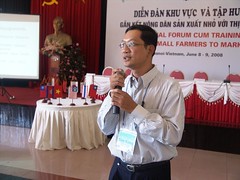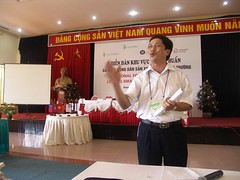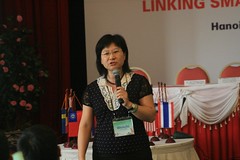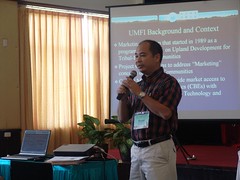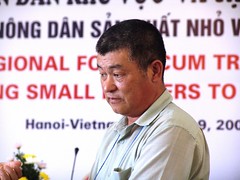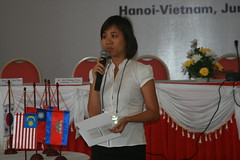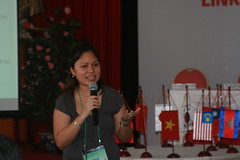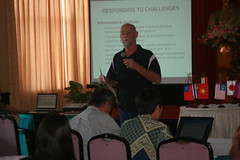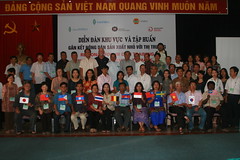Understanding Marketing and Agricultural Chains (Value Chain Analysis)
Session 2: Understanding Agricultural Chains Towards Enhanced Market Access
By Dr. Nellie Manalili, Regional Adviser for Asia on Market Access, Vredeseilanden (VECO)
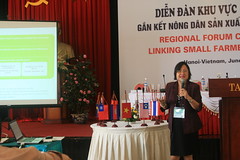 Much of the problems in the agricultural sector exist because we do not understand what is going on. That is why we need to understand what are agricultural chains and how these are linked to the market.
Much of the problems in the agricultural sector exist because we do not understand what is going on. That is why we need to understand what are agricultural chains and how these are linked to the market.
In a simple marketing system, there is the producer and the buyer. Goods are transferred from one to the other and it is through information and communication that a decision to buy/pay for a product is made. In reality, however, things are not as simple because of intermediaries in between. Products pass through these intermediaries and value is added to the chain where products take on a different form, e.g. from raw coconut to desiccated coconut or copra. The more intermediaries or participants there are in the chain, the greater chances for problems or distortions to happen. Farmers can also decide to add value (join the chain) if they determine that this will be more profitable for them. Otherwise, because of lack of the right information, they will be unable to benefit from the agricultural chain.
Another simple assumption is that producers will always have a ready market for their produce. This is often not the case and it will be important to 1) know market before you produce and 2) know your buyer and the agricultural chain they are in. Some questions that should be answered in relation to this are:
- Who are currently buying and supplying?
- Who are operating here?
- In what mode, form and at what price are they purchased?
- How is my product different or similar from others?
- What are potential entry points? (Sometimes this is learned by trial and error)
All products pass through a value chain. But now there is proliferation of professional buyers for retailers (i.e. supermarkets), which is affecting role of intermediaries and the market structure in general. In Asia, however, small markets are still popular and they co-exist with the big supermarkets (referred to as the dual face of agri-food markets). We are also finding new products in the supermarkets being offered as substitutes. These “changing rules in the games” and new standards set by other groups are creating dynamic markets where small producers are ill-equipped to compete. Even small producers who do not engage in these dynamic markets (they just deal with small, traditional markets) can be affected. This happens when suppliers that fail to meet retailer standards bring their products to the traditional market and increase the level of competition there.
In understanding agricultural chains, what is important to remember is that participants in the chain can only gain from their contribution to the chain. In joining a chain, we need to ask ourselves: Is the increase in price (what I will gain) commensurate to the value that I added? Did I make the right decision to add value or not in a given chain? The better we understand agricultural chains, the more we will be able to cut down transaction costs and enhance our position in the chain (by assuming other roles or participating in decision-making processes).
Download the Understanding Agricultural Chains Towards Enhanced Market Access.ppt
Read More...
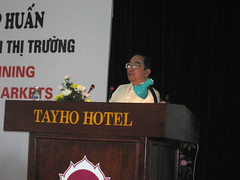 After communicating how happy he was to be back in Hanoi, Dr. Uriarte began with an introduction of ASEAN and the ASEAN Foundation. Asia as a region and ASEAN as an association is very diverse and currently composed of 10 member countries. ASEAN is targeting to have its own constitution by November 2008 and establish an ASEAN community among members by 2015. Established by the ASEAN in 1997, the ASEAN Foundation is pursuing two objectives: 1) to promote greater awareness of ASEAN, thus creating an ASEAN identity (e.g. Filipinos, Singaporeans, etc will think of themselves as Asians) and 2) to contribute to the evolution of a development cooperation strategy (academic, cultural, economic, social and other relevant government institutions and bona fide NGOs of ASEAN member countries can all avail of ASEAN Foundation funding)
After communicating how happy he was to be back in Hanoi, Dr. Uriarte began with an introduction of ASEAN and the ASEAN Foundation. Asia as a region and ASEAN as an association is very diverse and currently composed of 10 member countries. ASEAN is targeting to have its own constitution by November 2008 and establish an ASEAN community among members by 2015. Established by the ASEAN in 1997, the ASEAN Foundation is pursuing two objectives: 1) to promote greater awareness of ASEAN, thus creating an ASEAN identity (e.g. Filipinos, Singaporeans, etc will think of themselves as Asians) and 2) to contribute to the evolution of a development cooperation strategy (academic, cultural, economic, social and other relevant government institutions and bona fide NGOs of ASEAN member countries can all avail of ASEAN Foundation funding)


